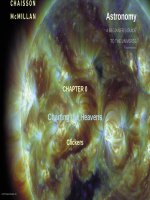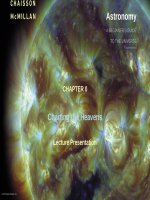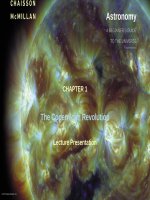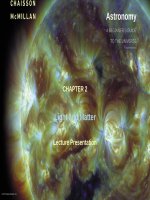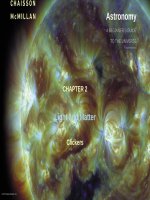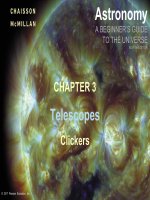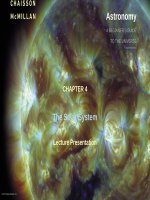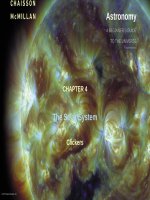Astronomy a beginners guide to the universe 7th edition chaisson test bank
Bạn đang xem bản rút gọn của tài liệu. Xem và tải ngay bản đầy đủ của tài liệu tại đây (288.16 KB, 28 trang )
Test Bank to Accompany
Astronomy: A Beginner’s
Guide to the Universe
Seventh Edition
by
Eric Chaisson and Steve McMillan
Pearson Education, Inc.
© 2013
9/11/12
Contents
Chapter 0
Charting the Heavens: The Foundations of Astronomy ............................................. 1
Chapter 1
The Copernican Revolution: The Birth of Modern Science ...................................... 18
Chapter 2
Light and Matter: The Inner Workings of the Cosmos ............................................. 29
Chapter 3
Telescopes: The Tools of Astronomy ........................................................................... 47
Chapter 4
The Solar System: Interplanetary Matter and the Birth of the Planets ................... 62
Chapter 5
Earth and Its Moon: Our Cosmic Backyard ................................................................ 85
Chapter 6
The Terrestrial Planets: A Study in Contrasts .......................................................... 107
Chapter 7
The Jovian Planets: Giants of the Solar System ........................................................ 127
Chapter 8
Moons, Rings, and Plutoids: Small Worlds Among Giants ................................... 146
Chapter 9
The Sun: Our Parent Star ............................................................................................ 170
Chapter 10
Measuring the Stars: Giants, Dwarfs, and the Main Sequence .............................. 189
Chapter 11
The Interstellar Medium: Star Formation in the Milky Way ................................. 212
Chapter 12
Stellar Evolution: The Lives and Deaths of Stars ..................................................... 233
Chapter 13
Neutron Stars and Black Holes: Strange States of Matter ...................................... 259
Chapter 14
The Milky Way Galaxy: A Grand Design ................................................................. 279
Chapter 15
Normal and Active Galaxies: Building Blocks of the Universe ............................. 304
Chapter 16
Galaxies and Dark Matter: The Large‐Scale Structure of the Cosmos .................. 331
Chapter 17
Cosmology: The Big Bang and the Fate of the Universe ........................................ 348
Chapter 18
Life in the Universe: Are We Alone? ......................................................................... 371
Chapter 0
Charting the Heavens: The Foundations of Astronomy
1) Right ascension in the sky is very similar to latitude on the Earth.
Answer: FALSE
Diff: 1
Section Ref.: 0.1
2) Latitude and right ascension are coordinate systems used to find objects on the celestial
sphere.
Answer: FALSE
Diff: 1
Section Ref.: 0.1
3) The celestial sphere is divided into 88 modern constellations.
Answer: TRUE
Diff: 1
Section Ref.: 0.1
4) In the sky, declination is measured in degrees north or south of the celestial equator.
Answer: TRUE
Diff: 1
Section Ref.: 0.1
5) The south celestial pole is located at a declination of -90 degrees.
Answer: TRUE
Diff: 1
Section Ref.: 0.1
6) In general, the brightest star in a given constellation is designated as alpha.
Answer: TRUE
Diff: 1
Section Ref.: 0.1
7) Constellations are close clusters of stars, all at about the same distance from the Sun.
Answer: FALSE
Diff: 1
Section Ref.: 0.1
8) The closest terrestrial analog to hours of right ascension is angle of longitude.
Answer: TRUE
Diff: 2
Section Ref.: 0.1
9) Over 20,000 stars are visible to the naked eye on the darkest, clearest nights.
Answer: FALSE
Diff: 2
Section Ref.: 0.1
1
Copyright © 2013 Pearson Education, Inc.
Astronomy: A Beginnerʹs Guide to the Universe, 7th ed.
10) A star with a right ascension of 2.6 hrs will rise 2.6 hours after the vernal equinox.
Answer: TRUE
Diff: 3
Section Ref.: More Prec. 0.1
11) A tropical year is the same as a sidereal year.
Answer: FALSE
Diff: 1
Section Ref.: 0.2
12) The sidereal day is determined by the Earthʹs rotation with respect to the stars.
Answer: TRUE
Diff: 1
Section Ref.: 0.2
13) The vernal equinox marks the beginning of spring in the northern hemisphere.
Answer: TRUE
Diff: 1
Section Ref.: 0.2
14) There are 3,600 arc seconds in a degree.
Answer: TRUE
Diff: 2
Section Ref.: More Prec. 0.1
15) An hour of right ascension corresponds to 60 degrees in the sky.
Answer: FALSE
Diff: 2
Section Ref.: 0.2
16) From Earth, the Sun and Moon have about the same angular diameter.
Answer: TRUE
Diff: 1
Section Ref.: 0.2
17) At the solstices, the Sunʹs declination will be 23.5 degrees from the equator.
Answer: TRUE
Diff: 2
Section Ref.: 0.2
18) At the equinoxes, the declination of the Sun must be zero degrees.
Answer: TRUE
Diff: 2
Section Ref.: 0.2
2
Copyright © 2013 Pearson Education, Inc.
Chapter 0 Charting the Heavens
19) As it orbits the Earth, the Moon appears to move its own diameter (0.5 degrees) eastward
every hour against the background stars.
Answer: TRUE
Diff: 3
Section Ref.: 0.3
20) From full moon to third quarter moon takes about a week.
Answer: TRUE
Diff: 1
Section Ref.: 0.3
21) Only people in the Moonʹs umbral shadow can see a total solar eclipse.
Answer: TRUE
Diff: 1
Section Ref.: 0.3
22) If we are the Moonʹs penumbra, then we will see a partial lunar eclipse.
Answer: FALSE
Diff: 1
Section Ref.: 0.3
23) There is a solar eclipse of some kind every new moon.
Answer: FALSE
Diff: 1
Section Ref.: 0.3
24) Eighteen days past new moon, the Moonʹs phase is waning gibbous.
Answer: TRUE
Diff: 2
Section Ref.: 0.3
25) A total solar eclipse will only occur when the new moon is both on the ecliptic and at its
greatest distance from Earth.
Answer: FALSE
Diff: 2
Section Ref.: 0.3
26) The larger the parallax shift, the closer an object is to us.
Answer: TRUE
Diff: 1
Section Ref.: 0.4
27) The parallax shift for all stars is very small.
Answer: TRUE
Diff: 1
Section Ref.: 0.4
3
Copyright © 2013 Pearson Education, Inc.
Astronomy: A Beginnerʹs Guide to the Universe, 7th ed.
28) Increasing the baseline will increase the parallax angle.
Answer: TRUE
Diff: 3
Section Ref.: 0.4
29) In the scientific method, it is not necessary to test your theory.
Answer: FALSE
Diff: 1
Section Ref.: 0.5
30) Drawing on Eratosthenesʹ method, if two observers are due north and south of each other and
are separated by 400 km, what is the circumference of their spherical world if they see the
same star on their meridian at altitudes of 23 degrees and 47 degrees respectively, and at the
exact same time?
A) 2,000 km
B) 4,000 km
C) 6,000 km
D) 8,000 km
E) 12,000 km
Answer: C
Diff: 3
Section Ref.: 0.4
31) The star Wolf 1061 has a parallax of 2.34 arc seconds, while the star Ross 652 has a parallax of
1.70 arc seconds. What can you correctly conclude?
A) Both stars are outside the Milky Way galaxy.
B) Wolf 1061 must have a larger proper motion than Ross 652.
C) Ross 652 must have a larger proper motion than Wolf 1061.
D) Ross 652 is closer to Earth than Wolf 1061.
E) Wolf 1061 is closer to Earth than Ross 652.
Answer: E
Diff: 2
Section Ref.: 0.4
32) The greatest distance above or below the ecliptic the Moon can move is
A) 5.2 degrees.
B) 23.5 degrees.
C) 27.3 degrees.
D) 29.5 degrees.
E) 30 degrees.
Answer: A
Diff: 3
Section Ref.: 0.3
4
Copyright © 2013 Pearson Education, Inc.
Chapter 0 Charting the Heavens
33) In an annular eclipse,
A) the Sun is totally blocked by the Moon.
B) the Moon is totally blocked by the Earth.
C) the Moon appears as a thin, bright ring.
D) the Sun appears as a thin, bright ring.
E) the Sun is partially blocked by the Earth.
Answer: D
Diff: 2
Section Ref.: 0.3
34) If you are in the Earthʹs umbra on the Earthʹs surface, then
A) it must be a total solar eclipse.
B) it must be a lunar eclipse of some type.
C) it is night time.
D) the Sun is always visible.
E) the Moon is always visible.
Answer: C
Diff: 2
Section Ref.: 0.3
35) The synodic month is
A) 29.5 days.
B) about two days shorter than the sidereal month.
C) based on the Moonʹs position relative to the stars.
D) the basis of the year we use in our modern calendar.
E) caused by both the Earthʹs and Moonʹs rotations.
Answer: A
Diff: 2
Section Ref.: 0.3
36) If the Moon appears half lit, and is almost overhead about 6:00 AM, its phase is
A) waxing crescent.
B) first quarter.
C) full.
D) third quarter.
E) waning crescent.
Answer: D
Diff: 2
Section Ref.: 0.3
37) If new moon fell on March 2nd, what is the Moonʹs phase on March 14th?
A) waxing crescent
B) first quarter
C) waxing gibbous
D) full
E) waning crescent
Answer: C
Diff: 2
Section Ref.: 0.3
5
Copyright © 2013 Pearson Education, Inc.
Astronomy: A Beginnerʹs Guide to the Universe, 7th ed.
38) A solar eclipse can only happen during a
A) new moon.
B) solstice.
C) first quarter moon.
D) full moon.
E) perihelion passage of the Sun.
Answer: A
Diff: 2
Section Ref.: 0.3
39) What will occur when the full moon is on the ecliptic?
A) a total lunar eclipse
B) a total solar eclipse
C) a partial solar eclipse
D) an annular lunar eclipse
E) a partial lunar eclipse if the Moon is at perigee
Answer: A
Diff: 1
Section Ref.: 0.3
40) If you are in the Moonʹs umbral shadow, then you are witnessing
A) nighttime.
B) a total solar eclipse.
C) a total lunar eclipse.
D) a partial solar eclipse.
E) some kind of lunar eclipse.
Answer: B
Diff: 1
Section Ref.: 0.3
41) The time for the Moon to orbit Earth, relative to the stars is
A) 23 hours, 56 minutes.
B) about 7 days.
C) 27.3 days.
D) 29.5 days.
E) 18 years, 11.3 days.
Answer: C
Diff: 1
Section Ref.: 0.3
42) The interval from new Moon to first quarter is about a(n)
A) hour.
B) day.
C) week.
D) month.
E) year.
Answer: C
Diff: 1
Section Ref.: 0.3
6
Copyright © 2013 Pearson Education, Inc.
Chapter 0 Charting the Heavens
43) The star Thuban in Draco
A) lies as the center of the precession cycle.
B) was an excellent north pole star in 3,000 BC.
C) is brighter than Polaris.
D) lies halfway between the bowls of the Big and Little Dippers.
E) is used to locate the vernal equinox.
Answer: B
Diff: 3
Section Ref.: 0.2
44) If Scorpius is now prominent in the summer sky, in 13,000 years it will be best seen
A) at the same season; the heavens do not change.
B) in the autumn.
C) in the winter sky.
D) in the spring sky.
E) It will not be visible then at all. All of its stars will have vanished by then.
Answer: C
Diff: 3
Section Ref.: 0.2
45) If Taurus is now rising at sunset, which constellation will rise at sunset next month?
A) Scorpius
B) Aquarius
C) Gemini
D) Aries
E) Pisces
Answer: C
Diff: 3
Section Ref.: 0.2
46) The fact that the Earth has moved along its orbit in the time it took to rotate once is the reason
for
A) the difference between solar and sidereal time.
B) precession.
C) seasons.
D) the position of the Celestial Equator.
E) Earthʹs 23.5-degree tilt.
Answer: A
Diff: 3
Section Ref.: 0.2
7
Copyright © 2013 Pearson Education, Inc.
Astronomy: A Beginnerʹs Guide to the Universe, 7th ed.
47) When the Moon is directly opposite the Sun in the sky, its phase is
A) new.
B) waxing or waning crescent.
C) first or third quarter.
D) waxing or waning gibbous.
E) full.
Answer: E
Diff: 2
Section Ref.: 0.2
48) You note that a particular star is directly overhead. It will be directly overhead again in
A) 1 hour.
B) 12 hours.
C) 23 hours 56 minutes.
D) 24 hours.
E) 24 hours 4 minutes.
Answer: C
Diff: 2
Section Ref.: 0.2
49) As you watch a star, you see it move 15 degrees across the sky. How long have you been
watching it?
A) 1 hour
B) 3 hours
C) 15 minutes
D) 15 seconds
E) 1 minute
Answer: A
Diff: 2
Section Ref.: 0.2
50) That Polaris will not always be the pole star is due to
A) the sidereal day being shorter than the solar day.
B) precession shifting the celestial pole.
C) the Moon following the ecliptic, instead of the equator.
D) the Earthʹs revolution being slightly less than exactly 365.25 days.
E) the Solar winds blowing the Earth farther away from the Sun.
Answer: B
Diff: 2
Section Ref.: 0.2
8
Copyright © 2013 Pearson Education, Inc.
Chapter 0 Charting the Heavens
51) From the horizon to the observerʹs zenith is an angle of
A) 30 degrees for observers at a latitude of 30 degrees North.
B) 90 degrees for everyone on the Earth.
C) 23.5 degrees for observers at the Tropics of Cancer and Capricorn.
D) 66.5 degrees for everyone on the Earth.
E) 0.0 degrees for an observer at the Earthʹs north pole.
Answer: B
Diff: 1
Section Ref.: 0.2
52) This diagram explains
A) the difference between solar time and sidereal time.
B) precession.
C) the solar dayʹs relation to the Moon.
D) the sidereal dayʹs relation to the seasons.
E) the reason for the solstices.
Answer: A
Diff: 1
Section Ref.: 0.2
9
Copyright © 2013 Pearson Education, Inc.
Astronomy: A Beginnerʹs Guide to the Universe, 7th ed.
53) The 26,000 year cycle that changes the poles and equinoxes is called
A) a retrograde loop.
B) the Earthʹs rotation.
C) precession.
D) regression.
E) revolution.
Answer: C
Diff: 1
Section Ref.: 0.2
54) The twelve constellations the solar system bodies move through are the
A) equatorial constellations.
B) signs of the zodiac.
C) nodes of the ecliptic.
D) galactic equator.
E) stages of heaven.
Answer: B
Diff: 1
Section Ref.: 0.2
55) A star with a right ascension of 1.0 hours will rise
A) 1.0 hours before the vernal equinox.
B) 13.0 hours before the vernal equinox.
C) 1.0 hours after the vernal equinox.
D) 11.0 hours after the vernal equinox.
E) at the same time as the vernal equinox.
Answer: C
Diff: 3
Section Ref.: 0.1
56) What are constellations?
A) Groups of galaxies gravitationally bound and close together in the sky.
B) Groups of stars making an apparent pattern in the celestial sphere.
C) Groups of stars gravitationally bound and appearing close together in the sky.
D) Ancient story boards, useless to modern astronomers.
E) Apparent groupings of stars and planets visible on a given evening.
Answer: B
Diff: 2
Section Ref.: 0.1
57) A star with a declination of +60.0 degrees will be
A) east of the vernal equinox.
B) west of the vernal equinox.
C) north of the celestial equator.
D) south of the celestial equator.
E) None of these answers are correct.
Answer: C
Diff: 2
Section Ref.: 0.1
10
Copyright © 2013 Pearson Education, Inc.
Chapter 0 Charting the Heavens
58) Into how many constellations is the celestial sphere divided?
A) 12
B) 44
C) 57
D) 88
E) 110
Answer: D
Diff: 1
Section Ref.: 0.1
59) In general, what is true of the alpha star in a constellation?
A) It is the brightest star in the constellation.
B) It is the easternmost star in the constellation.
C) It is the westernmost star in the constellation.
D) It is the reddest star in the constellation.
E) It is the star that is closest to Earth.
Answer: A
Diff: 1
Section Ref.: 0.1
60) Like latitude on Earth, ________ in the sky is measured in degrees north and south of the
equator.
Answer: declination
Diff: 1
Section Ref.: 0.1
61) The twelve constellations through which the Sun passes are signs of the ________.
Answer: zodiac
Diff: 1
Section Ref.: 0.2
62) The time interval of 365.242 days is defined as the ________.
Answer: tropical year
Diff: 1
Section Ref.: 0.2
63) The time for the Moon to orbit the Earth, relative to the distant stars is the ________.
Answer: sidereal month
Diff: 1
Section Ref.: 0.3
64) The apparent annual path the Sun takes through the sky is called the ________.
Answer: ecliptic
Diff: 1
Section Ref.: 0.3
11
Copyright © 2013 Pearson Education, Inc.
Astronomy: A Beginnerʹs Guide to the Universe, 7th ed.
65) If the Moon rises at sunset, then its phase must be ________.
Answer: full
Diff: 2
Section Ref.: 0.3
66) If the Moon is on the ecliptic, new, and at its farthest distance from Earth, we will get a(n)
________ solar eclipse.
Answer: annular
Diff: 2
Section Ref.: 0.3
67) Our seasons are a consequence of the Earthʹs 23.5 degree ________.
Answer: axial tilt
Diff: 1
Section Ref.: 0.3
68) Over the course of the year, the Sunʹs noon altitude varies by ________ degrees.
Answer: 47
Diff: 2
Section Ref.: 0.3
69) That we do not get eclipses every new and full Moon is due to the ________ degree tilt of the
Moonʹs orbit, relative to the ecliptic.
Answer: 5.2 (or just 5)
Diff: 2
Section Ref.: 0.3
70) The apparent angular shift of any object across a distant background, when viewed from two
different places, is called ________ shift.
Answer: parallax or parallactic
Diff: 1
Section Ref.: 0.4
71) Sirius has a parallax of 0.38ʺ, while Alpha Centauriʹs is 0.77.ʺ Alpha Centauri is about ________
as Sirius.
Answer: twice as close, or half as far
Diff: 1
Section Ref.: 0.4
72) If one star has a parallax ten times larger than anotherʹs, the first star is ________.
Answer: ten times closer than the second
Diff: 1
Section Ref.: 0.4
73) If two observatories on opposite sides of the Earth were to measure the position of a star to
calculate its parallax, then the diameter of the Earth would be the ________.
Answer: baseline
Diff: 2
Section Ref.: 0.4
12
Copyright © 2013 Pearson Education, Inc.
Chapter 0 Charting the Heavens
74) One of the requirements of the Scientific Method is that an experiment must be ________.
Answer: repeatable
Diff: 1
Section Ref.: 0.5
75) What do both latitude on Earth and declination in the sky measure?
Answer: Angular distance in degrees above or below the geographical and celestial equators.
Diff: 1
Section Ref.: 0.1
76) How is right ascension similar to longitude on Earth?
Answer: Both measure positions east or west from a fixed point; Greenwich on Earth, the vernal
equinox in the sky.
Diff: 1
Section Ref.: 0.1
77) What are the minimum and maximum values for declination in the sky for both north and
south?
Answer: From the equator at 0 degrees, to +90 degrees for the north celestial pole, and down to
-90 degrees for the south celestial pole.
Diff: 1
Section Ref.: 0.1
78) How are right ascension in the sky and longitude on Earth different?
Answer: Right ascension is measured in units of time eastward from the vernal equinox, while
longitude is measured in degrees east or west of the Greenwich meridian.
Diff: 2
Section Ref.: 0.1
79) Define the celestial sphere.
Answer: An imaginary hollow sphere, with Earth at its center, on which all the stars (and other
celestial bodies) are fixed. As the sphere rotates around the Earth, the stars move across
our sky.
Diff: 2
Section Ref.: 0.1
80) What are the minimum and maximum values for right ascension in the sky?
Answer: From 0 to 24 hours, going eastward from the vernal equinox.
Diff: 2
Section Ref.: 0.1
81) Which is longer, the sidereal or solar day? By how much?
Answer: The solar day is approximately four minutes longer than the sidereal day.
Diff: 1
Section Ref.: 0.2
13
Copyright © 2013 Pearson Education, Inc.
Astronomy: A Beginnerʹs Guide to the Universe, 7th ed.
82) At the solstice, what is the maximum angle the Sun can be above or below the equator?
Answer: +23.5 degrees in summer and -23.5 degrees in winter.
Diff: 1
Section Ref.: 0.2
83) How far above or below the ecliptic can the Sun move?
Answer: The Sun follows the ecliptic eastward across the sky, never leaving it.
Diff: 1
Section Ref.: 0.2
84) If intending to teach his students the constellations by season, why would an astronomy
instructor be advised to always assign the stars in the current western sky at the beginning of
each term?
Answer: As the Earth revolves around the Sun, the Sun appears to move one degree eastward
per day. These stars are, therefore, soon lost in the Sunʹs glare.
Diff: 2
Section Ref.: 0.2
85) Which star shows the least motion in the northern sky over the course of an hour?
Answer: Polaris, the North Star, lies within a degree of the celestial pole, and does not move
noticeably with the naked eye over an entire night.
Diff: 2
Section Ref.: 0.2
86) Pensacola, Florida lies at a latitude of 30 degrees north. Where is Polaris in its sky?
Answer: 30 degrees high in the north
Diff: 3
Section Ref.: 0.2
87) How far above or below the equator can the Sun appear to move? Why?
Answer: The Earthʹs axial tilt means the Sunʹs declination can reach 23.5 degrees north or south
of the equator at the solstices.
Diff: 1
Section Ref.: 0.3
88) What happens on or about March 20th, and what does the name signify?
Answer: The vernal equinox, because the days and nights are approximately equal in length.
Diff: 1
Section Ref.: 0.3
89) Why are some solar eclipses total, and others annular?
Answer: The Moonʹs orbit is not a perfect circle. When the Moon is closer to Earth, it is big
enough to cover the Sun completely; when it is too far away it appears smaller, so a ring
of sunlight is still seen.
Diff: 2
Section Ref.: 0.3
14
Copyright © 2013 Pearson Education, Inc.
Chapter 0 Charting the Heavens
90) What is the length of the sidereal month, and how is it determined?
Answer: It takes 27.3 days for the Moon to revolve around us and return to the same position
against the background of stars.
Diff: 2
Section Ref.: 0.3
91) How long does the synodic month take, and how it this observed?
Answer: The phase cycle of the Moon takes 29.5 days to return to exactly the same phase.
Diff: 2
Section Ref.: 0.3
92) How far above and below the celestial equator can the Sun move?
Answer: The Sun never appears more than 23.5 degrees above or the below the celestial equator.
Diff: 2
Section Ref.: 0.3
93) The first quarter moon rises about noon today; what will its phase be, and when will it rise
tomorrow?
Answer: It will be waxing gibbous, and rise about 1 PM by the next day.
Diff: 2
Section Ref.: 0.3
94) The last quarter moon rises tonight about midnight; when will it rise, and what will its phase
be tomorrow night?
Answer: It will rise about an hour later, about 1 AM, and be a waning crescent by then.
Diff: 2
Section Ref.: 0.3
95) If the Moon rises exactly at sunset, what will its phase be? Why?
Answer: The phase will be full because it is rising opposite the Sun.
Diff: 2
Section Ref.: 0.3
96) Why is Polaris not always the pole star, and when does it get another chance?
Answer: Precession of the Earthʹs axis of rotation takes around 26,000 years.
Diff: 3
Section Ref.: 0.3
97) If Sirius transits my local meridian tonight at 6:43 PM, when will it transit tomorrow?
Answer: At 6:39 PM tomorrow night, as the Earth spins once in a sidereal day.
Diff: 3
Section Ref.: 0.3
15
Copyright © 2013 Pearson Education, Inc.
Astronomy: A Beginnerʹs Guide to the Universe, 7th ed.
98) Compare and contrast latitude and declination. How does each relate to your position on
Earth?
Answer: Both are measured in degrees north or south of the equator, and are used to find
positions on the Earth or in the sky. If you are at latitude 30 degrees north, then the stars
that pass through your zenith (directly overhead) will have a corresponding declination
of +30 degrees.
Diff: 2
Section Ref.: 0.1
99) Compare and contrast longitude and right ascension.
Answer: Longitude is measured in degrees both east and west of the Greenwich meridian, but
right ascension is measured in units of time as the Earth rotates, and goes only eastward
from the vernal equinox.
Diff: 3
Section Ref.: 0.1
100) Compare hours of right ascension to time zones on the Earth.
Answer: Like time zones, hours of right ascension are 15 degrees wide, and they run eastward
across the sky from the Vernal Equinox, much like the time zones originate from the
Prime Meridian.
Diff: 3
Section Ref.: 0.1
101) The Sun and stars rise in the east, and set in the west. Contrast ancient and modern
explanations for this observation.
Answer: The ancients thought there was a vast celestial sphere, spinning over our heads once a
day, and that the stars, Sun, Moon, and planets are all carried along for the ride. We
now recognize it is the Earth itself that rotates eastward, creating this apparent
westward motion of celestial bodies.
Diff: 2
Section Ref.: 0.2
102) Contrast the sidereal and solar days.
Answer: The Earth rotates once on its axis every 23 hours, 56 minutes, and thus turns to face the
same distant star in that interval. But we are also revolving around the Sun at one
degree eastward per day, hence the Sun appears to have moved eastward from one day
to the next, and it takes a full 24 hours to align with the Sun again.
Diff: 2
Section Ref.: 0.2
103) Why can many more people witness a total lunar eclipse than a total solar eclipse?
Answer: For a total solar eclipse to be seen, the observer must be in the Moonʹs umbra, a shadow
only about a hundred miles across, while everyone on the night side of the Earth can
look up to witness the full moon moving though our shadow.
Diff: 2
Section Ref.: 0.3
16
Copyright © 2013 Pearson Education, Inc.
Chapter 0 Charting the Heavens
104) What conditions are necessary for a total solar eclipse?
Answer: The Moon must be at new phase (directly between Earth and the Sun), it must also be
both at the closer distance in its orbit and on the ecliptic (crossing a node). Only people
on those parts of the Earth where the Moonʹs umbral shadow passes will see a total
solar eclipse.
Diff: 2
Section Ref.: 0.3
105) What is the astronomical significance of 26,000 years?
Answer: The Earthʹs rotational axis itself rotates over this precession cycle, which also changes
the location of the poles, equinoxes, and solstices in the sky.
Diff: 2
Section Ref.: 0.3
106) Describe how Eratosthenes measured the circumference of our planet.
Answer: Using the fact that the noon solstice Sun was directly overhead at Syene, on the Tropic
of Cancer, yet was 7 degrees south of the zenith in Alexandria, Eratosthenes realized
this was due to the curvature of the Earth, and that the 7 degrees was about 1/50th of the
Earthʹs total circumference, so the Earth must be about fifty times larger in
circumference than the 800 kilometer separation between Alexandria and Syene, or
about 40,000 kilometers around.
Diff: 3
Section Ref.: 0.3
107) Which is longer, the sidereal or synodic month? Why?
Answer: The synodic month takes an extra two days, because the Earth is also revolving around
the Sun, so after 27.3 days the Moon returns to the same place among the stars, but the
Earth has revolved about 27 degrees ahead of where it was last month; it takes the
Moon two days to catch up to us.
Diff: 3
Section Ref.: 0.3
108) We get a new and full moon every month. Why donʹt we get two eclipses every month?
Answer: The Moonʹs orbit is tilted 5.2 degrees to the Earthʹs orbit (the ecliptic), and the disks of
the Sun and Moon are only about .5 degrees wide. Most months the new and full moon
pass too far from the ecliptic for the Earthʹs and Moonʹs shadows to make eclipses
occur.
Diff: 3
Section Ref.: 0.3
17
Copyright © 2013 Pearson Education, Inc.
Chapter 1
The Copernican Revolution:
The Birth of Modern Science
1) According to Newtonʹs third law, when the Voyager probes passed Jupiter in 1979, they exerted
exactly the same force on Jupiter as the giant planet did on them.
Answer: TRUE
Diff: 3
Section Ref.: 1.4
2) Compared to when it was on the surface, a satellite in an orbit whose radius is about 4 times
the Earthʹs radius will experience about 1/16 the force due to the Earthʹs gravity.
Answer: TRUE
Diff: 3
Section Ref.: 1.4
3) According to Newtonʹs second law, if you double the force acting on a body, the acceleration
will double.
Answer: TRUE
Diff: 2
Section Ref.: 1.4
4) According to Newtonʹs first law, an object traveling in a circle does not have a force acting on
it.
Answer: FALSE
Diff: 1
Section Ref.: 1.4
5) Keplerʹs third law allows us to find the average distance to a planet from observing its period
of rotation on its axis.
Answer: FALSE
Diff: 2
Section Ref.: 1.3
6) According to Keplerʹs third law, if you know the planetʹs orbital period, you can find its
average distance from the Sun.
Answer: TRUE
Diff: 2
Section Ref.: 1.3
7) A planet (or comet) will speed up as it approaches the Sun.
Answer: TRUE
Diff: 2
Section Ref.: 1.3
18
Copyright © 2013 Pearson Education, Inc.
Chapter 1 The Copernican Revolution: The Birth of Modern Science
8) Kepler found the orbits of planets are ellipses, not circles.
Answer: TRUE
Diff: 1
Section Ref.: 1.3
9) Kepler relied heavily on the telescopic observations of Galileo in developing his laws of
planetary motion.
Answer: FALSE
Diff: 2
Section Ref.: 1.3
10) Keplerʹs third law relates the square of the planetʹs orbital period in years to the cube of its
average distance from the Sun in astronomical units.
Answer: TRUE
Diff: 1
Section Ref.: 1.3
11) Among Galileoʹs discoveries with his telescope were sunspots.
Answer: TRUE
Diff: 1
Section Ref.: 1.2
12) Galileoʹs observations of the entire phase cycle of Venus proved that Ptolemyʹs epicycles could
not be correct in keeping Venus between us and the Sun.
Answer: TRUE
Diff: 1
Section Ref.: 1.2
13) According to Copernicus, retrograde motion occurs at opposition for the outer planets.
Answer: TRUE
Diff: 2
Section Ref.: 1.1
14) In Ptolemyʹs geocentric model, the planetʹs motion along its deferent is all that is needed to
understand retrograde motion.
Answer: FALSE
Diff: 1
Section Ref.: 1.1
15) Copernicus believed the Earth was the center of all celestial motion.
Answer: FALSE
Diff: 1
Section Ref.: 1.1
19
Copyright © 2013 Pearson Education, Inc.
Astronomy: A Beginnerʹs Guide to the Universe, 7th ed.
16) In Ptolemyʹs geocentric model, retrograde motion occurs when the planet is closest to us, on
the inside portion of the
A) deferent.
B) ellipse.
C) epicycle.
D) equant.
E) ecliptic.
Answer: C
Diff: 1
Section Ref.: 1.1
17) In Ptolemyʹs geocentric model, the normal eastward motion of the planets was along
A) a deferent.
B) an epicycle.
C) a retrograde loop.
D) an ellipse.
E) the equant.
Answer: A
Diff: 1
Section Ref.: 1.1
18) Copernicusʹ Heliocentric theory explains that
A) planetary orbits are elliptical in shape.
B) the Sun lies at one focus of an ellipse.
C) Venus retrogrades when she overtakes us at inferior conjunction.
D) all planets lie between the Sun and Earth.
E) Mars will retrograde when it reaches a certain position on its epicycle.
Answer: C
Diff: 2
Section Ref.: 1.1
19) According to Copernicus, retrograde motion for Venus must occur around
A) inferior conjunction, when it passes between us and the Sun.
B) quadrature, when the planet is 90 degrees away from the Sun.
C) greatest elongation, when the planet is farthest from the Sun.
D) superior conjunction, when the planet is on the far side of the Sun.
E) opposition, when the planet lies opposite the Sun in the sky.
Answer: A
Diff: 2
Section Ref.: 1.1
20
Copyright © 2013 Pearson Education, Inc.
Chapter 1 The Copernican Revolution: The Birth of Modern Science
20) According to Copernicus, the retrograde motion for Mars must occur
A) at inferior conjunction, when Mars laps the Earth and passes between us and the Sun.
B) at superior conjunction, when Mars lies on the far side of the Sun.
C) at quadrature, when Mars lies exactly 90 degrees east or west of the Sun.
D) at greatest elongation, when Mars can get up to 47 degrees from the Sun.
E) at opposition, when the Earth overtakes Mars and passes between Mars and the Sun.
Answer: E
Diff: 2
Section Ref.: 1.1
21) A fatal flaw with Ptolemyʹs model is its inability to predict the observed phases of
A) the Sun during an eclipse.
B) the Moon in its monthly cycle.
C) Mercury and Venus.
D) Mars and Jupiter.
E) Jupiter and Saturn.
Answer: C
Diff: 2
Section Ref.: 1.2
22) Which of these was NOT seen telescopically by Galileo?
A) sunspots
B) Venusʹ phase cycle
C) Four moons around Jupiter
D) stellar parallax
E) craters and mare on the Moon
Answer: D
Diff: 1
Section Ref.: 1.2
23) Which of these observations of Galileo refuted Ptolemyʹs epicycles?
A) the complete cycle of Venusʹ phases
B) the rotation of sunspots across the Sunʹs surface
C) the revolution of Jupiterʹs moons around it
D) the craters on the Moon
E) the visibility of many more stars with the telescope
Answer: A
Diff: 2
Section Ref.: 1.2
24) Galileo found the rotation period of the Sun was approximately
A) a day.
B) a week.
C) a month.
D) three months.
E) a year.
Answer: C
Diff: 3
Section Ref.: 1.2
21
Copyright © 2013 Pearson Education, Inc.
Astronomy: A Beginnerʹs Guide to the Universe, 7th ed.
25) Tycho Braheʹs contribution to Keplerʹs Laws of Planetary Motion were
A) his detailed and accurate observations of the planetsʹ positions.
B) his observations of Jupiterʹs moons.
C) a mathematical explanation of epicycles.
D) a precise lunar calendar.
E) the correct explanation of lunar phases.
Answer: A
Diff: 1
Section Ref.: 1.3
26) Keplerʹs first law worked, where Copernicusʹ original heliocentric model failed, because
Kepler described the orbits as
A) elliptical, not circular.
B) much larger than Copernicus had envisioned.
C) around the Sun, not the Earth.
D) being on equants instead of epicycles.
E) complex, with epicycles to account for retrograde motions.
Answer: A
Diff: 1
Section Ref.: 1.3
27) When a planetʹs orbit takes it closest to the Sun, itʹs called
A) vernal equinox.
B) aphelion.
C) perihelion.
D) crossing the ecliptic.
E) none of these; a planetʹs distance from the Sun never changes.
Answer: C
Diff: 2
Section Ref.: 1.3
28) A planet whose distance from the Sun is 3 AU would have an orbital period of how many
Earth-years?
A) 3
B) 27
C) 3
D) 9
E) 81
Answer: B
Diff: 3
Section Ref.: 1.3
22
Copyright © 2013 Pearson Education, Inc.
Chapter 1 The Copernican Revolution: The Birth of Modern Science
29) The force of gravity varies with the
A) product of the two masses.
B) inverse of the distance separating the two bodies.
C) inverse square of the distance separating the two bodies.
D) Both A and B are correct.
E) Both A and C are correct.
Answer: E
Diff: 1
Section Ref.: 1.4
30) A circular orbit would have an eccentricity of
A) 0.
B) between 0 and 0.5.
C) between 0.5 and 1.
D) exactly 1.0.
E) infinity.
Answer: A
Diff: 1
Section Ref.: 1.4
31) How much stronger is the gravitational pull of the Sun on Earth, at 1 AU, than it is on Saturn
at 10 AU?
A) 5
B) 10
C) 25
D) 100
E) 250
Answer: D
Diff: 3
Section Ref.: 1.4
32) If the distance between two asteroids is doubled, the gravitational force they exert on each
other will
A) also be doubled.
B) be half as great.
C) be one fourth as great.
D) will be 1/16 as great.
E) be four times greater.
Answer: C
Diff: 3
Section Ref.: 1.4
33) Because he failed to observe stellar ________, Aristotle wrongly concluded we could not be in
orbit around the Sun.
Answer: parallax
Diff: 1
Section Ref.: 1.1
23
Copyright © 2013 Pearson Education, Inc.
